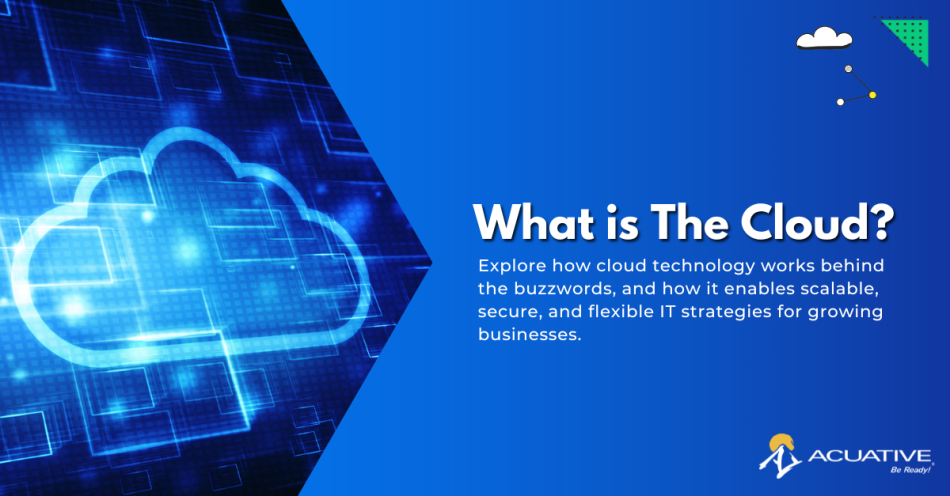July 14, 2025
Peter Kolodgy
These days, everything is “in the cloud.” Your files? In the cloud. Your apps? Also in the cloud. Your vacation photos from 2011? Hopefully in the cloud. But for all the talk, the cloud remains one of those buzzwords people throw around without really knowing what it means or how it actually works.
For businesses navigating digital transformation, remote work, and ever-growing data demands, the cloud isn’t just tech jargon, it’s the backbone of modern IT strategy. Still, making sense of it all requires more than just nodding along in meetings. You need a clear picture of how cloud technology works, what it enables, and how it can support your business goals.
This guide offers a practical overview of cloud computing: what it is, how it works, how Managed Service Providers (MSPs) leverage it, and how Acuative helps organizations make the move with clarity and confidence.
What is the Cloud?
The cloud refers to a network of remote servers hosted on the internet that store, manage, and process data, rather than relying on local servers or physical infrastructure.
Think of it like renting computing power and storage instead of owning it. Whether you’re using Google Drive, running Salesforce, or managing a global network through Microsoft Azure, you’re using the cloud.
Businesses use cloud platforms to:
- Run applications and services
- Store and analyze data
- Deploy infrastructure without owning physical hardware
- The cloud has become the de facto environment for innovation, agility, and scale.

How Does the Cloud Work?
At its core, cloud computing delivers IT resources like servers, storage, databases, and software over the internet rather than from local machines. These services are hosted in geographically distributed data centers owned and operated by cloud providers such as Amazon Web Services (AWS), Microsoft Azure, and Google Cloud Platform. Inside these data centers, physical hardware is divided into multiple virtual environments using virtualization, allowing for efficient resource sharing, isolation, and rapid deployment.
Cloud platforms provide on-demand access to computing power, with built-in elasticity, resources automatically scale up or down based on workload requirements. This reduces the need for businesses to maintain their own physical infrastructure, cutting down on capital expenses and maintenance.
There are three primary service models:
- IaaS (Infrastructure as a Service): Offers virtualized hardware so organizations can build their own environments (e.g., AWS EC2).
- PaaS (Platform as a Service): Provides a platform to develop and deploy applications without managing the underlying infrastructure (e.g., Heroku).
- SaaS (Software as a Service): Delivers ready-to-use software accessible via browser or app (e.g., Microsoft 365).
Regardless of whether a business uses a public, private, or hybrid cloud approach, the technology enables flexible, secure, and scalable operations from virtually anywhere, supporting remote work, business continuity, and digital transformation.
How MSPs Use the Cloud
Managed Service Providers use the cloud to deliver secure, scalable IT services that support business growth without adding complexity.
Key ways MSPs leverage the cloud:
- Centralized Monitoring & Management: 24/7 remote visibility across devices and locations
- Cloud Backup & Disaster Recovery: Ensure business continuity with secure data storage
- Virtualized Infrastructure: Offer clients IaaS without the CapEx
- Security-as-a-Service: Cloud-delivered threat detection and access control
- SD-WAN & Connectivity: Optimize network traffic across cloud applications
By abstracting the complexity of the cloud, MSPs empower businesses to focus on outcomes, not infrastructure.
Cloud Benefits vs. Drawbacks
Every business needs a clear-eyed view of the cloud’s strengths and potential trade-offs.
| Benefits | Drawbacks |
|---|---|
| Global Access – Work from anywhere | Internet Dependence – Downtime can impact access |
| Scalability – Add/remove resources instantly | Vendor Lock-In – Migration between providers can be complex |
| Cost Efficiency – Pay-as-you-go pricing | Compliance Risks – Sensitive industries must vet cloud regions |
| Built-in Security – Constant updates and patches | Less Control – Custom setups may be limited |
For most, the advantages outweigh the risks, but a business’s IT architecture should depend on its overall strategy.
Cloud Use Cases in Expanding Industries
As enterprises grow, they often face increasing complexity in operations, customer expectations, and data management. Cloud computing provides the agility and scalability needed to meet these demands, making it a powerful asset across industries like retail, banking, and healthcare.
In retail, cloud platforms enable seamless omnichannel operations by integrating inventory management, point-of-sale systems, and e-commerce platforms. Retailers can use cloud-based analytics to personalize customer experiences, track buying behavior, and respond to demand fluctuations in real time, especially during high-traffic events like holiday sales.
In the banking and financial services sector, the cloud supports the modernization of legacy infrastructure while maintaining compliance with strict regulatory standards. Financial institutions use cloud environments to host core banking platforms, detect fraud using AI and machine learning, and deliver secure, always-on mobile banking experiences. Cloud-based disaster recovery and data redundancy also help ensure business continuity.
In healthcare, cloud computing enables the secure storage and sharing of electronic health records (EHRs), making patient information accessible to authorized providers across locations. It supports the rapid scaling of telemedicine services, facilitates real-time collaboration among clinicians, and powers data-intensive research and diagnostics using advanced analytics and AI. Importantly, cloud providers offer compliance-ready environments that align with healthcare regulations such as HIPAA.
By adopting cloud technologies, growing organizations in these sectors gain the flexibility to expand, innovate, and respond quickly to shifting market demands without being constrained by physical infrastructure or outdated systems.
Common FAQs About the Cloud
Is the cloud secure?
Yes, but shared responsibility is key. Cloud providers secure infrastructure; your business must secure its configuration and access.
What’s the difference between public, private, and hybrid cloud?
- Public Cloud: Shared infrastructure (e.g., AWS, Azure)
- Private Cloud: Dedicated resources for one organization
- Hybrid Cloud: Combines both for flexibility and control
Can small businesses use the cloud?
Absolutely. The cloud levels the playing field, allowing SMBs to access enterprise-grade technology without upfront investment.
Is cloud more expensive than on-prem?
It depends on usage. For variable workloads or remote teams, the cloud is often more cost-effective long-term.
Acuative’s Cloud Services: Built for Agility, Backed by Expertise
At Acuative, we help organizations move to the cloud strategically, not reactively.
Whether you’re building a hybrid environment or going cloud-first, our managed solutions include:
- Secure SD-WAN with Cloud Integration
- AI-Powered Network Monitoring and Remediation
- Cloud-Based Backup, DR, and Business Continuity Planning
- Design, Implementation, and Ongoing Optimization
- Nationwide Field Engineering Support
- Connectivity Options from 100+ Global Carriers
Cloud computing is no longer optional, it’s foundational. But migrating alone can be risky. Acuative gives you the tools, strategy, and support to build a resilient, cloud-enabled future.
Ready to move smarter in the cloud?
Let’s talk about how Acuative can help your business modernize, secure, and scale with confidence.
About Peter Kolodgy
 With over four decades of successful business experience and more than $1 billion in goods and services sold across every continent, Peter Kolodgy brings a wealth of knowledge and expertise to Acuative’s Business Development team. A Cleveland, Ohio native, Peter has earned two college degrees and built a career driven by a passion for connecting businesses with innovative solutions. His global perspective and proven track record make him an invaluable asset in helping clients navigate the evolving world of network services and technology.
With over four decades of successful business experience and more than $1 billion in goods and services sold across every continent, Peter Kolodgy brings a wealth of knowledge and expertise to Acuative’s Business Development team. A Cleveland, Ohio native, Peter has earned two college degrees and built a career driven by a passion for connecting businesses with innovative solutions. His global perspective and proven track record make him an invaluable asset in helping clients navigate the evolving world of network services and technology.

